
ADF-SERIALS
Australian, New Zealand & Papua New Guinea Military Aircraft Serials & History
NEI Aircraft in Australia
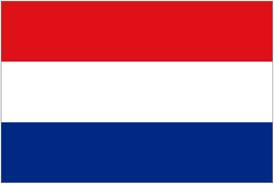
by Jos Heyman, Riverton, Australia
With the Japanese invasion of the Netherlands East Indies (NEI) in February and March 1942, a large number of aircraft owned by, or en-route destined for the NEI, were diverted to Australia and used by the RAAF or US services based in Australia. These involved aircraft of the Militaire Luchtvaart – Koninklijk Nederlandsch Indisch Leger (ML-KNIL), the Marine Luchtvaart Dienst (MLD) as well as the Koninklijke Nederlandsch Indische Luchtvaart Maatschappij (KNILM).
The history of these aircraft has been scattered over many reference sources. Some of these sources are solid and reliable whilst others started off as honest ‘assumptions’ which over time have been misquoted as ‘facts’, giving rise to conflicts that may never be resolved. Finally some data has not yet been recovered and may well have been lost permanently with the passing of time.
The following article summarises data that the author has found in published reference sources (books and websites) as well as data provided by correspondents (e-mails). It does not contain newly researched data although the ‘side-by-side comparison’ of data has allowed some outstanding queries to be resolved. The primary purpose of publishing the article is to draw out additional information and photos and/or corrections.
Additions and corrections are invited and should be forwarded to josheyman@hotmail.com.
Information on the fate of aircraft after their transfer to the RAAF, USAAF etc has been summarised, especially where such details are readily available on, for instance, the ADF Serials website.
Whilst, after the capitulation, the NEI was keen to remain in control of the aircraft it owned and had on order, the rule imposed by the US was that all aircraft arriving in Australia after 9 March 1942 were to be transferred to the USAAF 5th Air Force in Australia, the RAAF or the US Navy. Aircraft which had not been delivered (meaning ‘shipped from the US’) by 16 March 1942, were impressed in the US and were not shipped.
The ships which had carried the NEI aircraft from the US were the Kota Baroe (arrived in Tjilatjap on 27 February 1942 where it was unloaded), Zaandam (arrived in Tjilatjap in February 1942 but redirected to Fremantle where it arrived on 6 March 1942 and was probably unloaded), the Sloterdijk (arrived in Tjilatjap on 2 March 1942 but redirected to Fremantle where it arrived on 8 March 1942 and was probably unloaded), the Tossair (unloaded in Melbourne after arrival on 3 March 1942), the Tjibesar (probably unloaded in Albany after arrival on 4 March 1942), the Tarakan (unloaded in Sydney after arrival on 1 April 1942), the Tabian (probably unloaded in Fremantle after arrival on 9 March 1942), the Tjinegara (unloaded in Sydney after arrival on 10 March 1942), the Mapia (probably unloaded in Melbourne after arrival on 3 April 1942), the Weltevreden (unloaded in Sydney after arrival on 3 April 1942), the Tabinta (unloaded in Sydney after arrival on 5 April 1942) and the Bantam (unloaded in Sydney after arrival on 23 April 1942).
It should be noted that some of these ships may have called at other Australian ports at an earlier or later date.
The US continued to recognise a ‘debt’ to the NEI and in due course supplied replacement aircraft as part of Lend-Lease arrangements. These aircraft, mainly Mitchell bombers, P-40N fighters and Lodestar transports, are not included in this discussion.
ML-KNIL aircraft
Martin 139WH-3A
On 8 March 1942 a Martin 139WH-3A delivered to the ML-KNIL sometime in 1939, was flown from Andir to Australiawhere it was transferred to the USAAF. It was aircraft M-585 (c/n 843) and was formally transferred on 8 April 1942 when it received serial 42-68358 and was designated as RB-10. The fate of the aircraft is not clear. Some reference sources state that it remained in use until August 1944, whilst other sources state that it was used for spares, in particular its engines which were similar to those fitted on Lodestars.
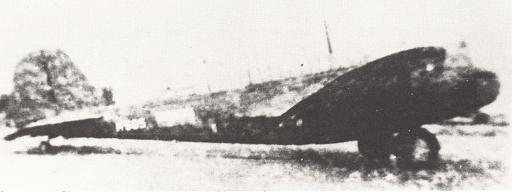
Martin 139WH-3A M-585
Lockheed L-12
A number of Lockheed L-12s destined for the ML-KNIL had been shipped from the United States to the NEI on the freighter Tarakan and were diverted to Australia. Although some reference sources have suggested that there were five aircraft on this ship (with serials L2-27, L2-31, L2-33, L2-34 and L2-35), it now seems evident from shipping records held in The Netherlands that the Tarakan carried only two aircraft, ie L2-34 and L2-31 or L2-33, with the others having been delivered to the NEI at an earlier date.
L2-34 (c/n 1302) went to the USAAF with locally applied serial 42-1302 and flew with the 3rd Bomb Group. There is no evidence to suggest that this aircraft, or for that matter the other aircraft, received a formal designation and serial or an Australian radio call sign. After the war it appeared on the civilian register as VH-ASG and eventually ended up in Malaysia as 9M-AMK. It crashed on 26 October 1966 at Bukit Besi, West Malaysia.
L2-31 (c/n 1299) or L2-33 (c/n 1301) went to 21st Squadron of the USAAF although some reference sources have suggested it was transferred to the US Navy in Australia. Other sources have suggested that this aircraft crashed end April 1942. The other aircraft (L2-31 or L2-33) is believed to have fallen into Japanese hands, probably after it was rendered inoperable by the ML-KNIL prior to the surrender.
Until recently it was thought that L2-35 (c/n 1303) was used by the ML-KNIL in Australia headquarters in Laverton where it flew with Australian radio call sign VHRDO. New information at hand, based on logbooks and documents of the 120th Squadron after its arrival in Soerabaja in April 1946 as well as letters and interviews undertaken by researchers in The Netherlands, now indicates that L2-35 was delivered via Tjilatjap in late 1941. It was abandoned during the capitulation and was recovered by the Japanese. It is thought it was given to an Indonesian Technical School and when recovered by the ML-KNIL in 1946 it still carried the original Dutch paint scheme with red-white-blue flags, except that the blue had been painted out. It was returned to flying condition again within two weeks. Eventually the aircraft was reserialled as L2-107 and, yet later as T-307. It was transferred to the Indonesian air force in June 1950 retaining the serial T-307.
Some reference sources have suggested that L2-27 (c/n 1295) was transferred to Australia and was then shipped to the United Kingdom where it arrived on 6 August 1942 on board of the Norwegian ship Hindanger.
It is, however, more likely that the aircraft, which had arrived at Andir in December 1941, was lost during a Japanese attack on Andir on 19 February 1942. The aircraft that arrived on the Hindanger, is believed to be a Lockheed L-12 (c/n 1275) formerly registered as NC18977 and owned by Pittsburgh Steel. It served with Dutch forces in the United Kingdom there and carried RAF serial NF753. Eventually it became T-5 of the Dutch air force and was written off in August 1949.
Lockheed Lodestar
In February 1942 the Depot Vliegtuig Afdeling of the ML-KNIL was formally transferred from NEI to Australia along with its aircraft. From that date its Lockheed Lodestars operated from Archerfield. Eleven aircraft were purchased by the US on 8 April 1942and assigned to ADAT. They received Australian call signs as well as USAAF serials. Their designation was C-56B for 42-68347/68357. It is possible that initially and for administrative reasons, they were also given a locally applied serial comprising ’41-‘ and the last three digits of the ML-KNIL serial, although there is no evidence to suggest that these serials were actually carried.
Photographic evidence, in particular Lodestar VHCAA and VHCAF, indicates that the assigned serials were not displayed prominently visible on the aircraft.
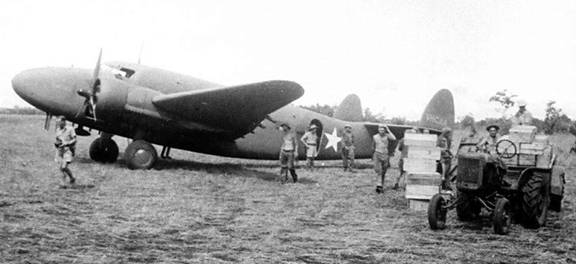
Lodestar VHCAA
Known details are:
· LT9-07 (c/n 18-2102), radio call sign VHCAA, went to the USAAF as 42-68347 and was operated by Qantas. It served in Australia and New Zealand after the war before going to the USA where it was current in 2004 as N796G.
· LT9-08 (c/n 18-2103), radio call sign VHCAB, went to the USAAF as 42-68348 and was operated by Qantas. It was written off on 26 November 1943 at Port Moresby.
· LT9-09 (c/n 18-2104), radio call sign VHCAC, went to the USAAF as 42-68349 and was operated by Guinea Airways. It served in Australia and New Zealand after the war and was written off on 10 February 1947 at Palmerston, New Zealand.
· LT9-14 (c/n 18-2109), radio call sign VHCAD, went to the USAAF as 42-68350. It was written off either on 14 July 1942 or in January 1944 at Tennant Creek.
· LT9-15 (c/n 18-2110) was withdrawn from use in Darwin in March 1942 whilst still in ML-KNIL service. Some reference sources have connected LT9-15 with Australian radio call sign VHCNB.
· LT9-16 (c/n 18-2120), radio call sign VHCAE, went to the USAAF as 42-68351 and was operated by Ansett. It was written off on 11 October 1942 at Archerfield.
· LT9-17 (c/n 18-2121), radio call sign VHCAF, went to the USAAF as 42-68352 and was operated by ANA. It was written off on 23 April 1944 at Archerfield.
· LT9-18 (c/n 18-2122) was written off on 3 March 1942 at Broome whilst still in ML-KNIL service.
· LT9-19 (c/n 18-2123), radio call sign VHCAG, went to the USAAF as 42-68353 and was operated by ANA(?). It was written off on 17 August 1942 at Maple.
· LT9-21 (c/n 18-2125), radio call sign VHCAH, went to the USAAF as 42-68354 and was operated by ANA. It was written off on 30 November 1942 at Dobodura, New Guinea.
· LT9-22 (c/n 18-2126) was written off on 15 February 1942 at Brisbane whilst still in ML-KNIL service.
· LT9-23 (c/n 18-2127), radio call sign VHCAI, went to USAAF as 42-68355. It was written off on 17 August 1942at Maple. Sometimes reported as current as N7001 but that aircraft is c/n 2427.
· LT9-24 (c/n 18-2128), radio call sign VHCAJ, went to the USAAF as 42-68356 and was operated by ANA. It was written off on 26 February 1943at Garbutt.
· LT9-25 (c/n 18-2129), radio call sign VHCAK, went to the USAAF as 42-68357 and was operated by Qantas. It was written off on 15 May 1944 at Bundaberg.
Serials LT-926/934 refer to another 9 Lockheed Lodestars which were not delivered in time and were impressed in the US for USAAF as C-60 with serials 42-108787/108792 and the US Navy as R5O-5 with serials 30149/30150.
North American B-25C
On 30 June 1941 the ML-KNIL ordered 162 North American B-25C Mitchells with first deliveries scheduled for March 1942. The ML-KNIL serials N5-122 to N5-283 were reserved for these aircraft. To speed up deliveries it was decided to swap the aircraft for similar aircraft earlier on the production line. The initial batch of 162 aircraft, which had NAA charge numbers 90-11819/11980, was eventually delivered to the USAAF as 42-53332/53493. The ML-KNIL serials were used again at a later date.
To replace them, and also reflecting the changed urgencies of the time, the USdiverted 60 B-25Cs from other orders to the ML-KNIL in January 1942.
These aircraft concerned had USAAF serials 41-12437, 41-12438, 41-12439, 41-12440, 41-12441, 41-12442, 41-12443, 41-12444, 41-12445, 41-12447, 41-12448, 41-12449, 41-12450, 41-12451, 41-12452, 41-12454, 41-12455, 41-12457, 41-12460, 41-12462, 41-12464, 41-12466, 41-12468, 41-12470, 41-12472, 41-12476, 41-12478, 41-12480, 41-12481, 41-12482, 41-12483, 41-12484, 41-12485, 41-12486, 41-12487, 41-12488, 41-12489, 41-12490, 41-12491, 41-12492, 41-12494, 41-12495, 41-12496, 41-12497, 41-12498, 41-12499, 41-12500, 41-12501, 41-12502, 41-12503, 41-12505, 41-12506, 41-12507, 41-12508, 41-12509, 41-12511, 41-12512, 41-12513, 41-12514 and 41-12515. The match-up between USAAF serials and ML-serials differs between reference sources however, the match-up published in 2006 was based on original research and corrected some mistakes that were introduced in the 1970s. A photo of a Mitchell displaying both the USAAF serial 41-12499 and the ML-serial N5-149 appeared in 2009 but it is believed this photo has been electronically modified with the wrong USAAF serial, which was 41-12438.
These aircraft were all test flown at Long Beach, apparently with NEI markings and serials in the range N5-122/181 and were considered to have been delivered to the ML-KNIL. From there they were flown to a Modification Centre in Memphis, TN, where the aircraft were brought up-to-date with the latest equipment. From here they were flown to Sacremento, CA or West Palm Beach, FL, from where they were to be ferried to the NEI. The plan was to fly aircraft N5-122/136, N5-149/163 and N5-172/181 from Sacramento to Australia whilst N5-137/148 and N5-164/171 were to be flown from West Palm Beachto India. From Australia and India they would have flown to the NEI. However, because the aircraft were not delivered to Sacramento and West Palm Beach in the planned order, the actual aircraft that were ferried had little to do with the plan. Because they had been accepted earlier, they were flown out as ML-KNIL aircraft.
By late February 1942 a number of aircraft were ready to be ferried from West Palm Beach to Accra. Two aircraft, including 41-12440, were damaged beyond repair at West Palm Beach and were not flown out. One aircraft, 41-12468, crashed en-route at Accra, Ghana. Africa. The ML-KNIL serials for these aircraft differ between reference sources. Eventually five reached Bangalore between 8 and 12 March 1942. By then the NEI had capitulated and the remainder of the ferry flights to Java could not be undertaken. Further flights from West Palm Beach had already been cancelled and the aircraft that were still there were transferred to Sacramento.
The five aircraft in Bangalore were 41-12495, 41-12445, 41-12509, 41-12507 and 41-12508. The match with the ML-KNIL serials N5-139, N5-143, N5-144, N5-145 and N5-148 differs between reference sources. The aircraft were flown by ML-KNIL personnel in cooperation with the RAF until, on 12 April 1942 they were handed over to the RAF. In some reference sources N5-139 and N5-143 have been associated with RAF serials MA956 and MA957. These were probably ‘administrative’ serials. These aircraft never reached the NEI or Australia.
On 23 March 1942 the USAAF withdrew the priority assignment of the B-25Cs to the ML-KNIL and instead it was decided that:
· 18 aircraft were to go to the ML-KNIL in Australia;
· 24 were to go to the USAAF in Australia;
· 5 were transferred to the RAF in India;
· 6 were retained by the USAAF for delivery to Brazil; and
· 4 were still at the Memphis Modification Centre and were retained by the USAAF.
This accounts for 57 aircraft – three others had already crashed.
Another fifteen aircraft had been ferried from California to Australia where they were delivered to the ML-KNIL in early March 1942 but were repossessed by US forces in Australia on 27 March 1942 using their former USAAF serial again.
These aircraft were 41-12494, 41-12443, 41-12455, 41-12466, 41-12462, 41-12511, 41-12480, 41-12483, 41-12498, 41-12501, 41-12439, 41-12437, 41-12438, 41-12464 and 41-12482. Again a match-up between the USAAF serials and ML-KNIL serials differs between reference sources.
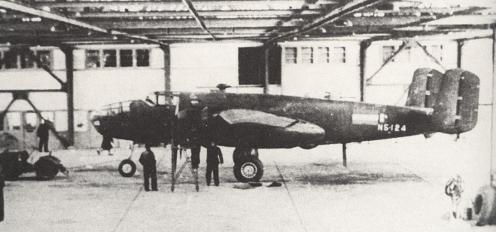
Mitchell N5-124
A number of other aircraft were retained by the USAAF with most of them, as far as can be ascertained, used in the south Pacific theatre of war. The USAAF serials of these aircraft were 41-12441, 41-12442, 41-12444, 41-12447, 41-12448, 41-12449, 41-12450, 41-12451, 41-12452, 41-12454, 41-12457, 41-12460, 41-12470, 41-12472, 41-12476, 41-12478, 41-12481, 41-12484, 41-12485, 41-12486, 41-12487, 41-12488, 41-12489, 41-12490, 41-12491, 41-12492, 41-12496, 41-12497, 41-12499, 41-12500, 41-12502, 41-12503, 41-12505, 41-12506, 41-12512, 41-12513, 41-12514, 41-12515. The ML-KNIL serials for these aircraft are not known.
Eventually the ML-KNIL forces in Australia, by then established as the 18th Squadron, RAAF, received B-25s. The first aircraft were some of those repossessed by the USAAF on 22 March 1942, which were returned to the ML-KNIL in July 1942 and received new serials in the third use of the N5 serials. They were N5-122 (41-12501), N5-123 (41-12439), N5-124 (41-12437), N5-125 (41-12464), N5-126 (41-12482) and N5-127 (41-12494). Other reference sources suggest that these aircraft were not repossessed by the USAAF and remained with the ML-KNIL with the new serials assigned around 21 June 1942. However, because they were essentially an ‘advance’ on other aircraft, they were returned to the USAAF on 1 September 1942.
This was followed by further aircraft supplied directly from the US from August 1942. These were serialed in the N5-128 to N5-266 range.
The B-25Cs were serialed N5-128/139 and N5-145/153. The B-25Ds were N5-137, N5-140/144 and N5-154/216, whilst the serials N5-217/266 were B-25J.
Two B-25Js, 44-31200 and 44-31257 were intended for the ML-KNIL but, before formal handover took place, they crashed, respectively at Sacramento on 2 June 1945 and Grass Valley on 1 June 1945. Their intended ML-KNIL serials are not known.
A number of these were eventually converted as TB-25 transports. Known serials are N5-129, N5-131, N5-134, N5-138, N5-142, N5-143, N5-146, N5-149, N5-158, N5-160, N5-163, N5-166, N5-172, N5-173, N5-184, N5-188, N5-244, N5-247, N5-248, N5-250, N5-261 and N5-263. In addition a number were converted for photo reconnaissance duties with the designation FB-25. These included N5-148, N5-151, N5-154, N5-164, N5-165, N5-178 and N5-208.
In addition there were a number of aircraft were fitted with eight machine guns in the nose and were used as strafers with the designation SB-25. Known serials were N5-218, N5-221, N5-223, N5-226, N5-228, N5-233, N5-234, N5-237, N5-239 and N5-240.
Known losses were N5-128 (20 January 1945), N5-130 (30 July 1945 at Cressy), N5-132 (5 February 1943 at McDonald Field), N5-133 (30 March 1943 at Melville Island), N5-135 (28 April 1943 at Dobo), N5-136 (7 October 1943 at Waingapu), N5-137 (5 January 1944 at Tenau), N5-139 (13 February 1943 at Port Keats), N5-140 (6 April 1943 at Darwin), N5-141 (7 November 1944 at Mascot), N5-144 (19 February 1943 at Dilli), N5-145 (18 October 1943 at Batchelor), N5-147 (23 May 1943 at Saumlaki), N5-150 (2 June 1943 at Lautem), N5-152 (23 May 1943 at Batchelor), N5-153 (10 September 1943 at Batchelor), N5-156 (28 September 1943 at Hughes), N5-157 (8 August 1944), N5-159 (21 November 1943 at Taberfane), N5-161 (8 December 1943 at Drysdale River), N5-162 (23 June 1944 at Tioor), N5-167 (19 December 1944 at Batchelor), N5-169 (25 August 1944 at Larat), N5-176 (30 May 1944 at Grove Island), N5-177 (18 May 1944 at Saumlaki), N5-179 (7 March 1944 at Toeal), N5-182 (29 March 1944 at Swan Hill), N-185 (1945), N5-191 (27 February 1944 at Hawaii on ferry flight), N5-210 (19 August 1944 at Langgoer), N5-211 (8 January 1945 at Batchelor), N5-214 (1 September 1944 at Langgoer), N5-217 (10 February 1945 at Fall Field), N5-222 (15 September 1944 at Langgoer), N5-230 (4 August 1946 at Kalibanteng), N5-236 (29 March 1945 at Merauke), N5-238 (2 July 1946 at Pakan Baroe), N5-241 (14 November 1944 at Canberra), N5-252 (21 July 1947 at Palembang), N5-253 (24 July 1945 at Archerfield), N5-254 (21 November 1945 between Truscott and Broome), N5-255 (4 September 1945 at Malino), N5-261 (22 December 1949 between Morotai and Makassar), N5-265 (15 April 1947 at Ambon-Biak) and N5-266 (1946).
In April 1944 the following aircraft were transferred to the RAAF: N5-168 as A47-35, N5-171 as A47-36, N5-174 as A47-37, N5-175 as A47-33, N5-181 as A47-3, N5-183 as A47-1, N5-186 as A47-34, N5-187 as A47-2, N5-189 as A47-4, N5-190 as A47-22, N5-192 as A47-5, N5-193 as A47-6, N5-194 as A47-7, N5-195 as A47-8, N5-196 as A47-9, N5-197 as A47-10, N5-198 as A47-11, N5-199 as A47-12, N5-200 as A47-13, N5-201 as A47-14, N5-202 as A47-15, N5-203 as A47-16, N5-204 as A47-17, N5-205 as A47-18, N5-206 as A47-19, N5-207 as A47-20, N5-212 as A47-23, N5-213 as A47-21, N5-215 as A47-25, N5-216 as A47-24, N5-219 as A47-27, N5-220 as A47-26, N5-224 as A47-28, N5-225 as A47-29, N5-227 as A47-32, N5-229 as A47-30, N5-231 as A47-31, N5-232 as A47-38 and N5-235 as A47-39. Most aircraft were transferred within days of being ferried from the United States where they had been handed over to the Dutch authorities at the RNMFS in Jackson, MS. Some reference sources have suggested that these aircraft where used there whilst carrying USAAF serials.
Curtiss Wright CW-22
The ML-KNIL had ordered 61 CW-22B Falcons of which 35 had been delivered to the NEI before the outbreak of hostilities. Another 21 were en-route to the NEI on board of the Sloterdijk (7) and the Tjibesar (14). The Sloterdijk sailed into Tjilatjap but did not unload and left for Fremantle on 2 March 1942. The Tjibesar was diverted to Australia whilst en-route. On arrival in Australia all 21 CW-22s were handed over to the USAAF.
Twelve were assigned to the 35th Pursuit Group of the USAAF and were probably flown with their construction numbers as serials. Eleven of the aircraft concerned were CF-4100 (c/n 3758), CF-4102 (c/n 3760), CF-4103 (c/n 3761), CF-4104 (c/n 3762), CF-4107 (c/n 3765), CF-4108 (c/n 3766), CF-4109 (c/n 3767), CF-4110 (c/n 3768), CF-4112 (c/n 3770), CF-4116 (c/n 3774) and CF-4118 (c/n 3776). The twelfth aircraft is believed to have been CF-499 (c/n 3536) although there is some doubt about the accuracy of the c/n which is probably should have been c/n 3736. However, since ML-KNIL flight logs indicate that CF-499 was flown by trainee pilots in the NEI in 1941 and does not have the range to fly to Australia, there is some doubt about the accuracy of this suggestion.
The 12 aircraft were recorded as received on 25 April 1942 and it is likely that 3760, 3765 and 3768 were used for spares. At least one remained in use in March 1944 with the 60th Depot Group in Post Moresby. The fate of the remaining aircraft is not clear but they may also have been used for spares. Some references have suggested that these aircraft never left the US.
A final five ML-KNIL aircraft (CF-4120/4124) never left the US and were transferred to the US Navy with serials 32987/32991. They were designated as SNC-1.
Curtiss P-40E
The ML-KNIL had ordered 140 Curtiss P-40Es. The construction numbers and ML-KNIL serials for the P-40Es are not known but it is possible they would be in the C-32xx range if indeed serials were ever reserved for them. However, there is no documentary evidence to support this assumption. None had been delivered prior to the Japanese invasion.
As the aircraft had already been paid for and the situation in the NEI was worsening, US authorities took several steps to speed up the delivery of P-40Es to the NEI by diverting aircraft from other production batches.
One of these steps was to send aircraft already in Australia to the NEI for use by the ML-KNIL and US forces which were operating there.
The first shipment consisted of 18 Curtiss P-40Es, broken down into major components and crated and which had shipped from the USon the Sea Witch. Another 9 aircraft were loaded on the deck of the Sea Witch in Melbourne. The Sea Witch was originally to have gone to Bombay and the aircraft would have gone to the RAF. Instead it was diverted to Tjilatjap where it arrived on 28 February 1942 and unloaded the aircraft. Of these aircraft 15 were transported by train to Andir and 12 to Tasikmalaja. As none of these aircraft were originally intended for the ML-KNIL, the service never assigned any serials to them. Some references have suggested that these aircraft would have been flown by the ML-KNIL’s 2.Vl.G.-IV squadron, if there would have been time.
The USAAF serials of the 27 aircraft were 40-607 (c/n 13482), 41-5512 (c/n 16504), 41-5556 (c/n 16548), 41-5561 (c/n 16553), 41-5566 (c/n 16558), 41-5569 (c/n 16561), 41-5587 (c/n 16579), 41-5601 (c/n 16593), 41-5604 (c/n 16596), 41-5605 (c/n 16597), 41-5608 (c/n 16600), 41-5623 (c/n 16615), 41-5625 (c/n 16617), 41-5626 (c/n 16618), 41-5627 (c/n 16619), 41-5629 (c/n 16621), 41-5630 (c/n 16622), 41-5631 (c/n 16632), 41-5637 (c/n 16629), 41-5639 (c/n 16631), 41-5640 (c/n 16632), 41-24812 (c/n 18831 or 19323), 41-24833 (c/n 18833), 41-24836 (c/n 18855), 41-24837 (c/n 18856), 41-24839 (c/n 18858) and 41-24841 (c/n 18860).
Three were assembled at Andir and the first one was flown on 7 March 1942. Of these three aircraft, two were flown to Pameungpeuk whilst the third one returned to Andir for repairs to its engine. It appears that these aircraft had simple numbers applied on the rudder with the number ‘3’ being known. This particular aircraft was later captured by the Japanese and flown with this number applied on the fuselage.
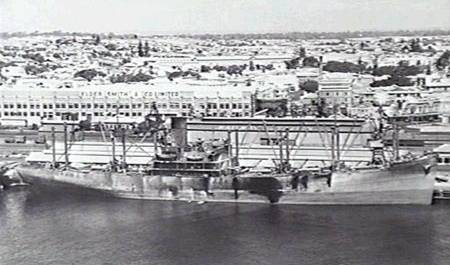
SeaWitch in Fremantle (Source: AWM via Gordon Birkett)
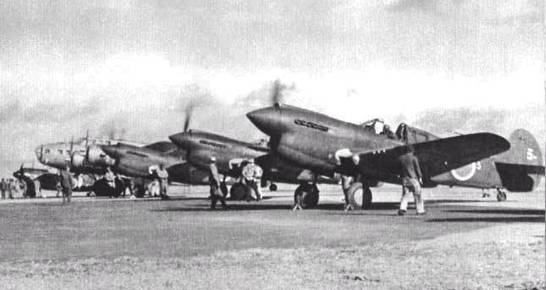
Captured P-40E with serial ‘3’
Some reference sources seem to draw the incorrect conclusion that a shipment of P-40Es on the USS Langley was intended for the ML-KNIL. Instead these were intended for two squadrons of the which operated from a base at Tjisaoek. This shipment had started off as 43 P-40Es of the 49th Pursuit Group in Australia which had been flown from Amberley and Bankstown to Maylands (Perth) of which only 34 reached Maylands. One was damaged in the landing at Maylands and was eventually transferred to the RAAF. The remaining 33 aircraft were checked by mechanics of ANA airlines at Maylands and on the night of 21-22 February 1942 they were towed along main roads to the port of Fremantle. Of these, 32 were loaded on the USS Langley, which was all it could take – planners had forgotten that the former aircraft carrier no longer had a full length deck. The final aircraft was flown back to Bankstown.
The Langley then sailed for Java with these aircraft but on 27 February 1942 the Langleywas attacked south of Tjilatjap by Japanese aircraft and was so badly damaged it had to be torpedoed by an escort and sank 100 km south of Tjilatjap.
A batch of 18 Lend-Lease P-40Es which had been shipped from the US on the Bantam, was earmarked for the ML-KNIL. These had USAAF serials 41-25163/25170, 41-25174/25181 and 41-25184/25185. After arrival in Australia in April 1942 they were diverted to the RAAF and USAAF. The ML-KNIL serials, if any, are not known. These aircraft were not part of the original order placed by the ML-KNIL.
Known details of the aircraft concerned are:
· c/n 19674 (USAAF 41-25163) went to the RAAF as A29-94 on 26 April 1942 but returned to USAAF two days later and was supplied to the 49th Pursuit Group. It was written off on 1 December 1942 at 17 Mile Drome.
· c/n 19675 (USAAF 41-25164) went to the RAAF as A29-92 on 26 April 1942 but returned to USAAF two days later and was supplied to the 49th Pursuit Group. It was written off on 27 December 1942.
· c/n 19676 (USAAF 41-25165) went to the USAAF 49th Pursuit Group. It was withdrawn from use on 29 December 1943.
· c/n 19677 (USAAF 41-25166) went to the RAAF as A29-92 on 13 May 1942. It was written off on 27 August 1942at Townsville.
· c/n 19678 (USAAF 41-25167) went to the USAAF 49th Pursuit Group. It was shipped back to the US and was withdrawn from use on 9 June 1944.
· c/n 19679 (USAAF 41-25168) went to the RAAF as A29-93 on 13 May 1942. It was written off on 12 August 1942at Milne Bay.
· c/n 19680 (USAAF 41-25169) went to the USAAF 49th Pursuit Group. It was shipped back to the USand was withdrawn from use.
· c/n 19681 (USAAF 41-25170) went to the USAAF 49th Pursuit Group. It was written off on 15 July 1943.
· c/n 19685 (USAAF 41-25174) went to the RAAF as A29-97 on 26 April 1942 but returned to USAAF two days later and was supplied to the 49th Pursuit Group. It was written off on 24 October 1943.
· c/n 19686 (USAAF 41-25175) went to the USAAF 49th Pursuit Group. It was written off on 17 August 1943at Gonotu Point.
· c/n 19687 (USAAF 41-25176) went to the RAAF as A29-94 on 13 May 1942. It was written off in February 1944 at Taren Point.
· c/n 19688 (USAAF 41-25177) went to the USAAF or, alternatively went to the RAAF as A29-99 on 26 April 1942 but returned to USAAF two days later. It was transferred again to RAAF as A29-95 in May 1942 and was written off on 8 November 1942 at Milne Bay.
· c/n 19689 (USAAF 41-25178) went to the USAAF 49th Pursuit Group. It was written off on 8 November 1942 at Kokoda.
· c/n 19690 (USAAF 41-25179) went to the USAAF 49th Pursuit Group. It was shipped back to the USand was withdrawn from use.
· c/n 19691 (USAAF 41-25180) went to the RAAF as A29-93 on 26 April 1942 but returned to USAAF two days later and was supplied to the 49th Pursuit Group. It was withdrawn from use on 18 August 1944.
· c/n 19692 (USAAF 41-25181) went to the RAAF as A29-96 on 26 April 1942 but returned to USAAF two days later and was supplied to the 49th Pursuit Group. It was written off on 13 June 1942 at Gun Point.
· c/n 19695 (USAAF 41-25184) went to the RAAF as A29-100 on 26 April 1942 but returned to USAAF two days later and was supplied to the 49th Pursuit Group. Its fate is not known.
c/n 19696 (USAAF 41-25185) went to the RAAF as A29-95 on 26 April 1942 but returned to USAAF two days later and was supplied to the 49th Pursuit Group. It was written off on 22 July 1942 at Livingston Strip.
Note that some of the RAAF serials of those aircraft transferred to USAAF were re-used.
In December 1943 the ML-KNIL, then operating within the RAAF, received the first of 67 P-40Ns to which serials C3-500/566 were assigned. Some of these aircraft were originally intended to be delivered to the RAAF whilst other aircraft that were originally intended to be delivered to the ML-KNIL, were eventually delivered to the RAAF. ML-KNIL aircraft transferred to the RAAF included USAAF serials 43-23205, 43-23207, 43-23209, 43-23211, 43-23213, 43-23215, 43-23217, 43-23218, 43-23219, 43-23222, 43-23224, 43-23539, 43-23540, 43-23542, 43-23543, 43-23794, 43-23901, 43-23903, 43-23904 and 43-24545 which went to the RAAF as resp. A29-603, A29-604, A29-605, A29-606, A29-637, A29-638, A29-639, A29-640, A29-641, A29-643, A29-644, A29-600, A29-601, A29-607, A29-634, A29-646, A29-648, A29-650, A29-654 and A29-645. There is no evidence to suggest that these aircraft received ML-KNIL serials before the transfer.
At about the same time several aircraft destined for the RAAF were transferred to the ML-KNIL. They carried ML-KNIL serials C3-524, C3-525, C3-526, C3-527, C3-528, C3-529, C3-530, C3-531 and C3-532. They were to be assigned RAAF serials A29-600, A29-601, A29-607, A29-634, A29-645, A29-646, A29-648, A29-650, and A29-654 respectively.
These aircraft were provided by the US under the Lend-Lease arrangements and were flown by the 120th (NEI) Squadron. After an initial training period they were deployed in New Guinea.
Known casualties included C3-500 (1 May 1947 at Andir), C3-503 (20 September 1944 at Merauke), C3-504 (1 August 1945 at Manokwari), C3-506 (16 April 1944 at Merauke), C3-508 (24 August 1944 at Merauke), C3-510 (5 May 1946 at Banjarmasin), C3-513 (20 December 1944 at Yass), C3-514 (25 July 1944 at Nassam), C3-515 (5 July 1944 at Cooks Bay), C3-518 (3 May 1946 at Tandjung Perak), C3-519 (12 June 145 at Canberra), C3-523 (28 November 1945 at Bundaberg), C3-524 (29 March 1944 at Mildura), C3-526 (4 July 1945 at Mokmer), C3-527 (29 March 1944 at Mildura), C3-528 (9 July 1945 en-route from Biak to Java), C3-530 (31 August 1944 at Merauke), C3-533 (17 February 1945 at Musselbrook), C3-534 (1 August 1945 at Manokwari), C3-535 (23 June 1944 at Canberra), C3-538 (29 January 1946 at Bundaberg), C3-539 (4 July 1945 at Mokmur Strip), C3-540 (7 July 1944 at Nassam), C3-541 (11 August 1945 at Manokwari), C3-542 (14 February 1945 at Tanahmerah), C3-543 (11 August 1944 at Amberley), C3-544 (19 September 1944 at Merauke), C3-545 (8 September 1944 at Merauke), C3-546 (18 July 1945 at Middleburg), C3-548 (14 February 1945 at Yea), C3-550 (19 September 1944 at Merauke), C3-553 (19 November 1944 at Merauke), C3-554 (9 December 1944 at Bardo Island), C3-557 (19 July 1945 at Doom Island), C3-561 (17 May 1946 at Tjililitan), C3-562 (1 August 1945 at Manokwari) and C3-566 (23 May 1945).
Other aircraft, including C3-521, C3-563, C3-564 and C3-566 were cannabilised for spare parts.
Aircraft C3-512 and C3-517, were not flown over to Java in April 1946 and were presumably written off or withdrawn from use at an earlier date.
By the end of 1946 26 aircraft remained operational.
Brewster Buffalo
To supplement their stock of Brewster Buffaloes ordered and delivered earlier, the ML-KNIL had ordered 20 of the 339-23 version for which it reserved the serials B-3167/B-3186. Their construction numbers are not known. These had not been delivered before the war broke out. In addition, six aircraft of the earlier 339D version, with serials B-3119 (c/n 314) and B-3162/3166 (probably c/n 384/388) had not yet been delivered. This makes a total of 26 aircraft that had not yet been delivered, although some reference sources suggest that only 21 aircraft had not yet been delivered.
The ’26 argument’ is based on the suggestion that five crated Buffaloes had arrived in Tjilatjap on the Zaandam in the final days of the war. As the port of Tjilatjap was full, the cargo could not be unloaded and the Zaandam, after taking on 892 refugees, sailed on to Fremantle. However, according to the shipping manifest, the load consisted mainly of scrap iron, thereby casting doubt on the suggestion that these aircraft were delivered. Moreover, it seems that B-3162/3166 were still in the US on 1 April 1942. It is possible that these aircraft had been kept in the US by the Dutch for possible deployment with Dutch forces in Suriname, a plan that never materialised. There is no evidence either to support their deployment in Australia and their fate is not known.
The remaining 21 aircraft were en-route on the Mapia (4), Sloterdijk (10), Tabian (3) and Tjibesar (4) and were diverted to Australia.
In Australia they were initially diverted to the USAAF and by March 1942, eight had been assembled by the USAAF 4th Air Force Geelong. Of these six were transferred to the RAAF as A51-1 to A51-6 and were converted as photo reconnaissance aircraft. These were B-3171 (A51-1), B-3175 (A51-2), B-3177 (A51-3), B-3184 (A51-4), B-3185 (A51-6) and B-3186 (A51-5). The other two remained with the USAAF, including former B-3119.
The other thirteen Buffaloes were assembled for the USAAF by Ansett Airways at Essendon and were put into service with locally applied serials in the 301 to 313 series (in some reference sources referred to as ‘Ansett erection number’, although this seems to be a post-war term). Some of these were subsequently transferred to the RAAF with serials in the A51-7 to A51-15 range.
It has not been possible to match aircraft with USAAF serials 304 and 313 to a ML-KNIL aircraft whilst the fate of ML-KNIL aircraft B-3169, B-3170 and B-3173 cannot be traced. They could have been broken up for parts – in particular their engines although there is photographic evidence of 313 having flown.
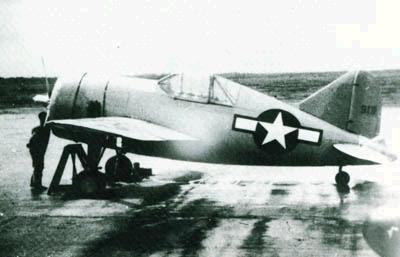
Brewster Buffalo USAAF 313
Known details of the aircraft concerned are:
· B-3119 went to the USAAF as 3119. It had earlier flown with that serial in the US. Its fate in Australiais not known.
· B-3167 went to the USAAF as 310. Later it went to the RAAF as A51-13 and was withdrawn from use after November 1943.
· B-3168 went to the USAAF as 309. Later it went to the RAAF as A51-12 and was withdrawn from use after July 1943.
· B-3169 of which its fate in Australia is not known.
· B-3170 of which its fate in Australia is not known.
· B-3171 went to the USAAF without a serial. Later it went to the RAAF as A51-1 and was withdrawn from use after September 1943.
· B-3172 went to the USAAF as 301. Later it went to the RAAF as A51-7 and was withdrawn from use after November 1943.
· B-3173 of which its fate in Australia is not known.
· B-3174 went to the USAAF as 311. Later it went to the RAAF as A51-14. Some references have this aircraft withdrawn from use after June 1943 whilst others references have suggested it crashed south west of Derbywhere it was found in 1980. The remnants then went to the USA, via Sydney, eventually arriving at the Aviodrome collection in The Netherlands.
· B-3175 went to the USAAF without a rerial. Later it went to the RAAF as A51-2 and was written off on 8 July 1942at Tallarook.
· B-3176 went to the USAAF as 305. Later it went to the RAAF as A51-9 and was withdrawn from use after January 1944.
· B-3177 went to the USAAF without a serial. Later it went to the RAAF as A51-3 and was withdrawn from use after June 1943.
· B-3178 went to the USAAF as 307. Later it went to the RAAF as A51-10 and was withdrawn from use after July 1943.
· B-3179 went to the USAAF as 308. Later it went to the RAAF as A51-11 and was withdrawn from use after July 1943. The remnants then went to the USA, via Sydney, eventually arriving at the Aviodrome collection in The Netherlands.
· B-3180 went to the USAAF as 303. Later it went to the RAAF as A51-16 and was withdrawn from use after November 1943.
· B-3181 went to the USAAF as 302. Later it went to the RAAF as A51-8 and was withdrawn from use after October 1943.
· B-3182 went to the USAAF as 306. Later went to the RAAF as A51-17 and was withdrawn from use after September 1943.
· B-3183 went to the USAAF as 312. Later went to the RAAF as A51-15 and was withdrawn from use after June 1943.
· B-3184 went to the USAAF without a serial. Later it went to the RAAF as A51-4 and was written off on 16 June 1942at Laverton.
· B-3185 went to the USAAF without a serial. Later it went to the RAAF as A51-6 and was written off on 29 October 1942 at Darwin.
· B-3186 went to the USAAF without a serial. Later it went to the RAAF as A51-5 and was written off on 25 September 1942 at Derby.
The link between the ML-KNIL serial and the USAAF/RAAF serial cannot be confirmed with certainty in some cases, due to lack of documentary evidence.
In addition to the parts of B-3174 and B-3178, the Aviodrome in The Netherlands has parts of an ex USAAF aircraft identified as ‘304’. It is intended to use the parts of the three aircraft to rebuild a Buffalo, using a replica fuselage.
MLD aircraft
Dornier Do-24K
On 19 February 1942 the MLD flew Dornier Do-24Ks with serials X-5, X-7, X-8, X-9, X-10 and X-24 to Australia where all of them, except X-24, were transferred to the RAAF.
The aircraft arrived in Rathmines with no beaching gear or equipment and they were run up in the mud, with the intention to be abandoned. The bottoms of the aircraft had holes in them which were patched up with concrete. The RAAF stripped the aircraft completely of the electrical wiring and replated the hulls, following which they were mainly used as transports. Eventually they were abandoned at Lake Boga.
X-24 was retained by the MLD until 8 November 1943 when it was also transferred to the RAAF.

Dornier Do-24 A49-3 (Source: RAAF)
The details are:
· X-5 (c/n 765) went to the RAAF as A49-1 on 29 April 1942. It was withdrawn from use on 20 December 1944.
· X-7 (c/n 767) went to the RAAF as A49-2 on 29 April 1942. It was withdrawn from use in 1944.
· X-8 (c/n 768) went to the RAAF as A49-3 on 29 April 1942. It was withdrawn from use on 20 December 1944.
· X-9 (c/n 769) went to the RAAF as A49-4 on 29 April 1942. It was withdrawn from use on 20 December 1944.
· X-10 (c/n 770) went to the RAAF as A49-5 on 29 April 1942. It was withdrawn from use on 11 March 1944 at Darwin.
· X-24 (c/n 785) remained with the MLD until it went to the RAAF as A49-6 in October 1943. It also used Australian radio call sign VHPHB and was withdrawn from use on 20 December 1944.
Ryan STM
The Ryan STM was the standard trainer for the MLD which was used with and without floats at Perak and Morokrembangan. On 19 February 1942 the MLD managed to ship 36 Ryan STMs to Australia on the ship Tjinegara where they arrived in Sydney on 10 March 1942. Initially it was intended to establish a flying school in Australia but with the establishment of the Royal Netherlands Military Flying School in Jackson, Mississippi, the Ryan STMs became surplus. The aircraft were sold to the RAAF and, after assembly by Qantas at Rose Bay, were delivered between June 1942 and August 1942. The RAAF used the aircraft for a variety of purposes.
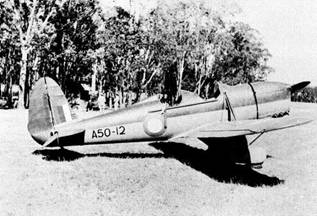
Ryan A50-12 (Source: RAAF)
Details of 35 aircraft are:
· S-14 (c/n 450) went to the RAAF as A50-7 on 26 June 1942. It was withdrawn from use on 20 March 1945 and eventually became VH-AHF.
· S-16 (c/n 452) was possibly stored with RAAF but did not receive a RAAF serial. It became VR-HDY in 1947 and eventually found its way to the Netherlands where it is on display.
· S-17 (c/n 453) went to the RAAF as A50-24 on 4 August 1942. It was written off on 7 April 1945 at Evans Head.
· S-18 (c/n 454) went to the RAAF as A50-27 on 17 August 1942. It was withdrawn from use on 21 January 1945 and eventually became VH-AGU.
· S-19 (c/n 455) went to the RAAF as A50-25 on 17 August 1942. It was written off on 7 April 1945at Evans Head.
· S-21 (c/n 457) went to the RAAF as A50-30 on 27 August 1942. It was withdrawn from use on 7 April 1945 and eventually became VH-BBJ.
· S-22 (c/n 458) went to the RAAF as A50-17 on 10 June 1942. It was withdrawn from use on 19 April 1945 and eventually became VH-AGV.
· S-23 (c/n 459) went to the RAAF as A50-11 on 20 June 1942. It was withdrawn from use on 5 April 1945 and eventually became VH-AGD.
· S-24 (c/n 460) went to the RAAF as A50-15 on 10 June 1942. It was withdrawn from use on 16 November 1943
· S-25 (c/n 461) went to the RAAF as A50-33 on 27 August 1942. It was withdrawn from use on 20 March 1945.
· S-26 (c/n 462) went to the RAAF as A50-21 on 4 August 1942. It was withdrawn from use on 12 November 1942.
· S-27 (c/n 463) went to the RAAF as A50-12 on 10 June 1942. It was written off on 18 May 1944 at Sale.
· S-28 (c/n 464) went to the RAAF as A50-4 on 13 July 1942. It was withdrawn from use on 12 June 1944 and eventually became VH-ARR.
· S-29 (c/n 465) went to the RAAF as A50-22 on 4 August 1942. It was withdrawn from use on 19 April 1945 and eventually became VH-AGW.
· S-30 (c/n 466) went to the RAAF as A50-18 on 28 August 1942. It was withdrawn from use on 19 April 1945 and eventually became VH-AGR.
· S-31 (c/n 467) went to the RAAF as A50-2 on 21 July 1942. It was withdrawn from use on 16 October 1946 and eventually became VH-ARS.
· S-33 (c/n 469) went to the RAAF as A50-34 on 7 August 1942. It was withdrawn from use on 7 April 1945 and eventually became VH-AHD.
· S-35 (c/n 471) went to the RAAF as A50-23 on 10 June 1942. It was withdrawn from use on 19 April 1945 and eventually became VH-DBD.
· S-37 (c/n 473) went to the RAAF as A50-1 on 21 July 1942. It was withdrawn from use on 28 August 1945 and eventually became VH-AGQ.
· S-39 (c/n 475) went to the RAAF as A50-9 on 26 June 1942. It was withdrawn from use on 3 July 1944 and eventually became VH-AGR.
· S-40 (c/n 476) went to the RAAF as A50-31 on 27 August 1942. It was withdrawn from use on 18 April 1945 and eventually became VH-AGZ.
· S-41 (c/n 477) went to the RAAF as A50-10 on 20 June 1942. It was written off on 26 April 1943 at Charters Towers.
· S-45 (c/n 481) went to the RAAF as A50-32 on 27 August 1942. It was withdrawn from use on 23 January 1945 and eventually became VH-AHA.
· S-46 (c/n 482) went to the RAAF as A50-19 on 10 June 1942. It was withdrawn from use on 24 September 1944.
· S-47 (c/n 483) went to the RAAF as A50-5 on 13 July 1942. It was withdrawn from use on 5 April 1945 and eventually became VH-ARG.
· S-48 (c/n 484) went to the RAAF as A50-28 on 17 August 1942. It was withdrawn from use on 20 March 1945.
· S-49 (c/n 485) went to the RAAF as A50-14 on 10 June 1942. It was written off on 7 April 1945 at Evans Head.
· S-50 (c/n 486) went to the RAAF as A50-16 on 10 June 1942. It was written off on 9 December 1943.
· S-51 (c/n 487) went to the RAAF as A50-8 on 26 June 1942. It was withdrawn from use on 28 March 1945.
· S-53 (c/n 489) went to the RAAF as A50-13 on 10 June 1942. It was withdrawn from use on 23 March 1945 and eventually became VH-AGS.
· S-54 (c/n 490) went to the RAAF as A50-26 on 10 August 1942. It was withdrawn from use on 23 March 1945 and eventually became VH-AGX.
· S-55 (c/n 491) went to the RAAF as A50-20 on 10 June 1942. It was withdrawn from use on 9 February 1944.
· S-56 (c/n 492) went to the RAAF as A50-29 on 27 August 1942. It was withdrawn from use on 7 April 1945 and eventually became VH-AHC.
· S-57 (c/n 493) went to the RAAF as A50-6 on 13 July 1942. It was withdrawn from use on 16 April 1945 and eventually became VH-AGB.
· S-58 (c/n 494) went to the RAAF as A50-3 on 13 July 1942. It was withdrawn from use on 16 April 1945 and eventually became VH-AHG.
No details are known of the 36th aircraft but it was probably used for spares.
De Havilland Tiger Moth
On 19 February 1942 the MLD shipped 6 De Havilland Tiger Moths to Australia on board of the Tjinegara along with the Ryan STMs as described separately. They were former Vrijwillig Vlieger Corps aircraft that had been loaned to, but not formally impressed by, the MLD although this has not been confirmed. Note that the MLD had serials S-1 to S-10 reserved for impressed aircraft but these may not have been used for the Tiger Moths.
After being unshipped in Sydney, the aircraft were supplied to the RAAF.
The following details of these aircraft are known.
· PK-VVQ (c/n DHA453) went to the RAAF as A17-621. Eventually it was withdrawn from use and became VH-BKH.
· PK-VVR (c/n DHA464) went to the RAAF as A17-622. Eventually it was withdrawn from use and became VH-EVS.
· PK-VVS (c/n DHA465) went to the RAAF as A17-623. It was written off on 25 July 1945.
· PK-VVT (c/n DHA466) went to the RAAF as A17-624. Eventually it was withdrawn from use and became VH-AMH.
· PK-VVU (c/n DHA467) went to the RAAF as A17-625. Eventually it was withdrawn from use and became VH-WFF.
· PK-VVW (c/n DHA468) went to the RAAF as A17-626. Eventually it was withdrawn from use in 1954 and became VH-GWB.
Douglas DB-7B
The Marine Luchtvaart Dienst (MLD) ordered 48 Douglas DB-7Cs on 16 October 1941. These were to be c/n 6265/6312 and were to carry MLD serials D-47 to D-94 (D-1 to D-46 were Dornier Wal flying boats). For some reason Douglas assigned the serials DO-101 to DO-148 to these aircraft and it has been reported that DO-104 was tested by the US Navy.
The DO serials, which are in a typical ML-KNIL serial format, could be interpreted as evidence that the aircraft were to go to the ML-KNIL. There is, however, no indication whatsoever in the reference sources consulted that the ML-KNIL ever intended to get the DB-7C and the DO serials may indeed have been an effort by a Douglas official who had seen other ML-KNIL aircraft with serials such as LT (for the Lockheed Lodestar) and CW (for Curtiss Wright aircraft).
With the outbreak of the Pacific War there was an urgent need to provide adequate combat aircraft to the Netherlands East Indies and the US authorities allowed the order for 48 DB-7Cs to lapse. Eventually, the aircraft were completed as Lend-Lease aircraft that were diverted to Russia. It is not known which serials they carried.
To meet the immediate need in NEI, and in-lieu of the lapsed order for 48 DB-7Cs, US authorities assigned 32 DB-7Bs from an English order (which may have included a number of aircraft originally ordered by France) to the Netherlands East Indies. These aircraft had been retained by the USAAF after Pearl Harbour and were originally earmarked for delivery to China. The assignment to the NEI took place on 24 December 1941. The MLD serials D-95 to D-126 might have been reserved for these although other evidence suggests that they may have been serialled from D-49 onwards, if not from D-47. As they had been part of a direct order by the RAF, none of these aircraft received USAAF serials. No construction numbers are known. Some of these aircraft seemed to have carried the black marking ‘Kon. Marine’, as applied by Douglas, whilst traces of their original French number, eg 240 for AL907, also remained visible.
The first six aircraft arrived on 27 February 1942 in the port of Tjilatjap on the MS Kota Baroe. Which aircraft were involved is unclear. Some references have suggested that the RAF serials were AL359 (c/n 2740), AL360 (c/n 2741), AL903 (c/n 3835), AL904 (c/n 3836), AL905 (c/n 3837) and AL906 (c/n 3838), although AL903 might have been AL901 (c/n 3833) due to a record mix-up. But there are also references that AL360 crashed at Hunter AAF, GA (USA) on 17 June 1942 and AL905 at McClellan Field, CA (USA) on 10 December 1941 whilst AL359 has been recorded as having been withdrawn from use at Olmstead Field, PA on 2 February 1943. Other references include AL347, AL358, AL361 to AL369, AL887, AL890 to AL895, AL897 to AL899 and AL907.
One unidentified aircraft was assembled and flown to Tasikmalaja on 5 March 1942 (the main road behind the port facilities at Tjilatjap had been widened to serve as a runway). Tasikmalaja was used as a central point from which salvageable equipment would be packed and transported to Australia. The aircraft was intended to go to Andir but, because of lack of 100 octane fuel, could not be flown to Andir and was instead, set on fire during the capitulation. A second, partially assembled aircraft, AL904, was captured by the Japanese and was repaired and eventually flown in Japan with serial J-D-A-1. In 1945 it was found at the Atsugi air base in Japan. The remaining four aircraft were railed to Bandoeng for assembly but were captured, unassembled, by the Japanese. It has been suggested one of these was assembled and flown.
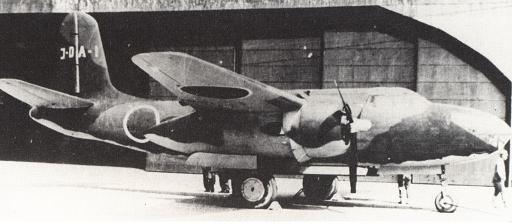
DB-7B captured by Japan
At the time another 22 DB-7Bs were on their way to Java on the Mapia (6), Tabinta (3), Tarakan (5), Tossair (3) and Weltevreden (5) but were diverted to Australia where they arrived on, resp. 3 March 1942, 6 March 1942, 3 April 1942, 7 April 1942 and 26 April 1942. As the aircraft concerned were originally part of an RAF order, they had been given British serials. Their intended MLD serials are not known. Subsequently they were transferred to the RAAF with serials A28-1 to A28-22. A number of these (viz. A28-4, -5, -8, -9, -11, -12, -15, -16, -18 and -22) were actually first delivered to the 18th (NEI) Squadron (ie the ML-KNIL) however, it has not been possible to determine the assigned ML-KNIL serial, if indeed such assignment ever took place.
The known details of these aircraft are:
· RAF AL890 (c/n 3822) went to the RAAF as A28-1. It was written off on 4 July 1944 at Kiriwina.
· RAF AL347 (c/n 2728) went to the RAAF as A28-2. It was written off on 19 May 1942 at Richmond.
· RAF AL887 (c/n 3819) went to the RAAF as A28-3. It was written off on 18 March 1943 at Salamaua.
· RAF AL893 (c/n 3825) went to the RAAF as A28-4. It was written off on 7 January 1943 at Port Moresby.
· RAF AL895 (c/n 3827) went to the RAAF as A28-5. It was written off on 22 January 1944.
· RAF AL897 (c/n 3829) went to the RAAF as A28-6. It was written off on 22 November 1944 at Morotai.
· RAF AL899 (c/n 3831) went to the RAAF as A28-7. It was written off on June 1944 at Milne Bay.
· RAF AL907 (c/n 3839) went to the RAAF as A28-8. Displayed in RAAF Museum, Pt Cook.
· RAF AL891 (c/n 3823) went to the RAAF as A28-9. It was written off on 14 December 1942 at Membari River.
· RAF AL358 (c/n 2739) went to the RAAF as A28-10. It was written off on 22 November 1944 at Morotai.
· RAF AL364 (c/n 2745) went to the RAAF as A28-11. It was withdrawn from use in February 1945.
· RAF AL365 (c/n 2746) went to the RAAF as A28-12. It was written off on 10 November 1942 at Port Moresby.
· RAF AL367 (c/n 2748) went to the RAAF as A28-13. It was written off on 1 January 1943 at Hood Point.
· RAF AL892 (c/n 3824) went to the RAAF as A28-14. It was written off on 9 February 1943 at Malahang.
· RAF AL361 (c/n 2742) went to the RAAF as A28-15. It was written off on 12 September 1943 at Gasmata Island.
· RAF AL362 (c/n 2743) went to the RAAF as A28-16. It was written off on 12 September 1943 at Gasmata Island.
· RAF AL363 (c/n 2744) went to the RAAF as A28-17. It was written off on 18 May 1942 at Richmond.
· RAF AL366 (c/n 2747) went to the RAAF as A28-18. It was written off on 18 September 1943 at Rockhampton.
· RAF AL368 (c/n 2749) went to the RAAF as A28-19. It was written off on 9 October 1942 at Woodford.
· RAF AL369 (c/n 2750) went to the RAAF as A28-20. It was written off on 29 November 1942 at Gona Mission.
· RAF AL894 (c/n 3826) went to the RAAF as A28-21. It was written off on 6 February 1943 at Salamaua.
· RAF AL898 (c/n 3830) went to the RAAF as A28-22. It was written off on 26 November 1942 at Buna.
It has been suggested that 28 A-20Gs were reserved through Lend-lease to raise a squadron in Australia but the 18th (NEI) Squadron was already being equipped with Mitchell bombers. Nevertheless, from 12 June 1942 the 18th (NEI) Squadron, located in Australia, received a number of A-20As from the USA. These aircraft were relinquished again by 23 June 1942. These included aircraft with USAAF serials 40-077, 40-082, 40-101 and 40-153 it is seems that some of these were transferred to the RAAF.
Vought-Sikorsky Kingfisher
In November 1941 the MLD ordered 24 Vought-Sikorsky Kingfishers. It has been suggested that they were ordered through the US Navy as OS2U-3 with serials 5966/5989 although other sources have suggested that the first seven were built by the Naval Aircraft Factory as OS2N-1 and the balance by Vought Sikorsky. This latter suggestion might be supported by reference material found in 2011 indicating that the aircraft US Navy serial 5983 was written off at NAS Banana River in Florida on 9 January 1943.
When the war broke out, the 24 aircraft were en-route to NEI on the Mapia (10), Tabian (7) and Weltevreden (7) and were diverted to Australia where they arrived in March and April 1942. Of these 18 were transferred to the RAAF for use with 107 Squadron. The other six aircraft, presumably with the MLD serials V-1 to V-6, were diverted to the US Navy at Noumea where they probably flew with their original serials 5966/5971.
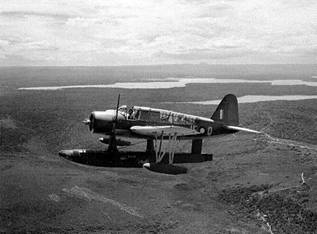
Vought A48-15 (Source: RAAF)
The known details of each aircraft, as they are generally published, are:
· V-7 (USN 5972) went to the RAAF as A48-8 on 6 May 1942. It was written off on 14 January 1943, off Sydney.
· V-8 (USN 5973) went to the RAAF as A48-9 on 6 May 1942. It was withdrawn from use on 21 January 1953.
· V-9 (USN 5974) went to the RAAF as A48-10 on 6 May 1942. It was written off on 4 October 1944 off Jervis Bay.
· V-10 (USN 5975) went to the RAAF as A48-11 on 6 May 1942. It was withdrawn from use on 6 September 1945.
· V-11 (USN 5976) went to the RAAF as A48-12 on 6 May 1942. It was withdrawn from use on 21 August 1945.
· V-12 (USN 5977) went to the RAAF as A48-13 on 6 May 1942. It was withdrawn from use on 21 January 1953.
· V-13 (USN 5978) went to the RAAF as A48-14 on 6 May 1942. It was withdrawn from use on 21 August 1945.
· V-14 (USN 5979) went to the RAAF as A48-15 on 6 May 1942. It was withdrawn from use on 2 April 1951.
· V-15 (USN 5980) went to the RAAF as A48-16 on 6 May 1942. It was withdrawn from use on 26 September 1943.
· V-16 (USN 5981) went to the RAAF as A48-17 on 6 May 1942. It was withdrawn from use on 20 March 1946.
· V-17 (USN 5982) went to the RAAF as A48-7 on 22 April 1942. It was withdrawn from use on 21 December 1943.
· V-18 (USN 5983) went to the RAAF as A48-18 on 6 May 1942. It was withdrawn from use on 29 August 1945.
· V-19 (USN 5984) went to the RAAF as A48-1 on 22 April 1942. It was withdrawn from use on 22 May 1945.
· V-20 (USN 5985) went to the RAAF as A48-2 on 22 April 1942. It was withdrawn from use on 22 August 1945.
· V-21 (USN 5986) went to the RAAF as A48-3 on 22 April 1942. It was withdrawn from use on 22 August 1945.
· V-22 (USN 5987) went to the RAAF as A48-4 on 22 April 1942. It was withdrawn from use on 22 August 1945.
· V-23 (USN 5988) went to the RAAF as A48-5 on 22 April 1942. It was withdrawn from use on 19 August 1945.
· V-24 (USN 5989) went to the RAAF as A48-6 on 22 April 1942. It was withdrawn from use on 21 August 1943.
There is, however, some doubt about the accuracy of the above links. Some of the RAAF record cards for the aircraft concerned (ie A48-9 to A48-18) have a cross reference to the MLD serial typed on the card, indicating that those links are most likely correct. Other cards have the link to the MLD serial written in separately raising the suspicion this was this was done significantly later (1998 has been suggested), and the correctness of the links must treated with a fair degree of suspicion. The RAAF record cards do not make a reference to the US Navy serials or a construction number.
Consolidated Catalina
Throughout February and March 1942 Catalina flying boats of the MLD were flown out of the NEI. On 10 March 1942 five of them were at Rathmines. They were Y-45, Y-49, Y-62, Y-69 and Y-71. The aircraft were not transferred to Australian or US authorities and remained under the control of the MLD. In May 1942 they were flown to Ceylonto join up with other MLD Catalinas to serve as a Dutch detachment to RAF units there.

Catalina Y-69 (Source: Afd. Mar. Hist. – MLD)
Five aircraft had been transferred to the US Navy’s VP-22 squadron in January 1942 in which service they flew with locally applied markings 22-P-41/45 (other aircraft in that squadron carried similar markings in as 22-P-xx format). The possible MLD aircraft concerned were Y-39, Y-41, Y-42, Y-43, Y-46 and Y-50 although one of these had been bombed at Morokrembangan at an earlier date. VP-22 had arrived in Ambon on 11 January 1942 but was equipped with earlier Catalinas without self-sealing tanks and armor. On 5 February 1942 the squadron flew to Darwin and by 25 February 1942 had lost all but three of its aircraft. These were diverted to Soerabaja on that day where they stayed until 1 March 1942 when the squadron moved to Perth.
All the former MLD aircraft had, however, been lost before 5 February 1942.
VP-22 also operated a Catalina with locally applied marking 22-P-46 which, according to references, was built up from MLD aircraft Y-42 and US Navy aircraft 22-P-12. It was pressed into service on 28 February 1942 and was flown to Australia. Its subsequent fate is not known.
In addition VP-22 had abandoned a Catalina with marking 22-P-3 at Tjilatjap on 2 March 1942. This aircraft was repaired by MLD mechanics, given the serial Y-3 and flown to Australia, where it was handed back to the US Navy on 7 March 1942.
Civilian aircraft
Douglas DC-2
Two Douglas DC-2-115Gs owned by KNILM, PK-AFK and PK-AFL, were flown to Australia on 28 February 1942. Between 15 and 18 May 1942 they were purchased by ADAT and received Australian radio call signs.
PK-AFK (c/n 1375) received radio call sign VHCXH and was also given the locally applied USAAF serial 41-1375. On 14 June 1944it received the formal serial 44-83226 and was designated as C-32A. Its fate is not clear. One report suggests it was destroyed at Charters Towers, Qld, on 23 June 1942, whilst flying for the 21st Troop Carrier Squadron, whilst another report suggests that, after having been damaged several times, it was eventually withdrawn from service in 1946 and scrapped at Essendon.
PK-AFL (c/n 1376) received radio call sign VHCXG and was also given the locally applied USAAF serial 41-1376. On 14 June 1944 it became formally 44-83227 and was designated as C-32A.
After the war it was sold to ANA as VH-ADZ on 27 January 1944 and later as VH-CDZ of Marshall Airlines. Eventually this aircraft became N8486D and was reported with the Confederate Air Force in February 1983. Its subsequent fate is not known. The registration VH-CDZ has also been associated with former RAAF A30-9 (c/n 1292) which has been put on display in Darwin’s Aviation Heritage Centre.
Some reference sources have suggested that a third aircraft, PK-AFJ (c/n 1374) was also flown to Australia but this aircraft crashed in December 1941 at Darmo (Surabaya).
Douglas DC-3
Two Douglas DC-3-194Bs owned by KNILM were flown to Australia on 28 February 1942 (PK-ALT) and 6 March 1942 (PK-ALW). Between 15 and 18 May 1942 they were transferred to ADAT and received Australian radio call signs.
PK-ALT (c/n 1941) received radio call sign VHCXD and was also given the locally applied USAAF serial 41-1941. On 14 June 1944it was serialed as 44-83228 and designated as C-49H. It eventually crashed at Higgins Field on 5 May 1945.
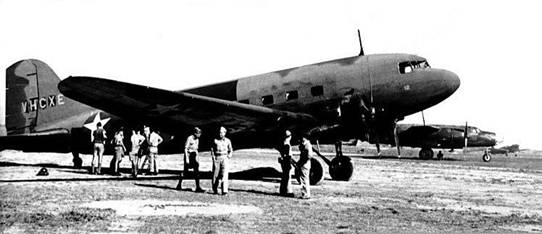
Douglas DC-3 VHCXE (Source: McArthur Memorial Archives)
PK-ALW (c/n 1944) received radio call sign VXCXE and was also given the locally applied USAF serial 41-1944. It received the serial 44-83229 on 14 June 1944, when it was also designated as C-49H. It was used as General McArthur’s aircraft in 1942/43 before being transferred to the RAAF as VHCXL. On 1 April 1944 the aircraft was purchased by Australian National Airways and was registered as VH-ANR. The aircraft is displayed in the Queensland Air Museum at Caloudra.
Douglas DC-5
Three Douglas DC-5-511s, PK-ADB, PK-ADC and PK-ADD, owned by KNILM were flown to Australia on 28 February 1942. Between 15 and 18 May 1942 they were transferred to ADAT and received Australian radio call signs.
PK-ADB (c/n 428), with radio call sign VHCXA, received locally applied USAAF serial 41-428. On 20 June 1944 it was formally serialed as 44-83230 and was designated as C-110. Before that, it had crashed at Lurnea Siding on 6 November 1942.
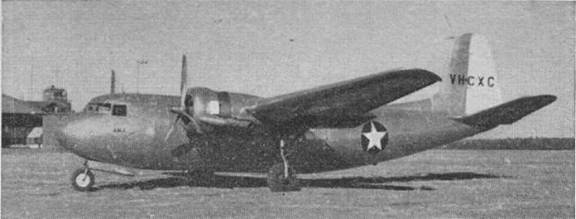
Douglas DC-5 VHCXC
PK-ADC (c/n 424), with radio call sign VHCXB, received locally applied USAAF serial 41-424. It was serialed 44-83231 on 20 June 1944. Like the two other aircraft, it was designated as C-110. Before that it had been destroyed by enemy fire at Port Moresby on 18 August 1942.
PK-ADD (c/n 426), with radio call sign VHCXC, may have received the locally applied USAAF serial 41-426. On 20 June 1944 it was serialed as 44-83232 and was designated as C-110. It was sold to Australian National Airways in December 1945 and was registered as VH-ARD. Later it was acquired by New Holland Airways and in May 1948 the aircraft left Darwin for Rome, to collect Italian migrants and fly these back to Australia. On the way it stayed overnight at Kemajoran where it was noticed that the nose wheel was welded fixed. After leaving Kemajoran it is alleged the aircraft picked up twenty Indonesian air force cadets in Rangoon and flew these to India where they received flying training (the cadets had earlier flown from Sumatra to Rangoon on an Indonesian Douglas DC-3.
Once in Italy, the aircraft was sold to Israel where it was used by the Israelair force until it was stored and broken up. It is likely that it was never intended to make the return migrant flight to Australia.
It should be noted that older references show PK-ADC with c/n 426 and PK-ADD with c/n 424. It is now believed this is incorrect.
The fourth KNILM DC-5, PK-ADA (c/n 430) was not in a flight ready state at the time of evacuation and was eventually captured by the Japanese forces, repaired and flown to Japan for tests.
Lockheed L-14
Three Lockheed L-14-WF62s (PK-AFN, PK-AFP and PK-AFQ) owned by KNILM were flown to Australia on 28 February 1942 where they were used by KNILM under charter to the military. Between 15 and 18 May 1942 they were transferred to ADAT where they served with the 21st Troop Carrier Squadron. They received Australian radio call signs.
PK-AFN (c/n 1414), radio call sign VHCXI, received locally applied USAAF serial 41-1414. On 20 June 1944 it received the formal serial 44-83233 and was designated as C-111. Earlier it had crashed near Alice Springs on 14 February 1944.
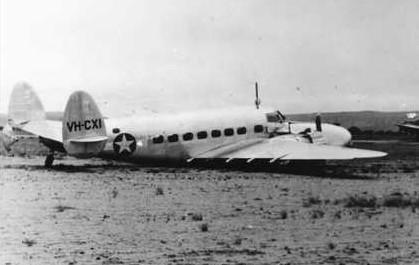
44-83233 (Source: SA State Library)
PK-AFP (c/n 1442), radio call sign VHCXJ, received locally applied USAAF serial 41-1442. On 20 June 1944 it received the formal serial 44-83234 and was designated as C-111. flew until 16 May 1944 when it was withdrawn from use by ADAT. It seems to have remained in limited use until March 1945 and was eventually broken up in 1975.
PK-AFQ (c/n 1443), radio call sign VHCXK, received locally applied USAAF serial 41-1443. On 20 June 1944 it received the formal serial 44-83235 and was designated as C-111. Before that it had crashed near Cooktown on 8 October 1942.
A fourth Lockheed L-14, PK-AFM (c/n 1411), has also been flown to Australia on 28 February 1942 but was written off on 26 March 1942 near Katherine. At that time it was still operated by KNILM.
Note on the USAAF serials
As stated, the former KNILM aircraft (the DC-2s, DC-3s, DC-5 and L-14s) were assigned Australian radio call signs as well as locally applied USAAF serials based on the aircraft’s construction numbers. Photographic evidence, in particular DC-5 VHCXC and DC-3 VHCXE, indicates that the locally applied serials were not carried on the aircraft tails or in other visible positions. It is possible that these serials were only used to make locally kept records conform to some USAAF administrative standard. At worst, these serials are a post-war invention by some misguided ‘historian’.
The USAAF serials 44-83226/83235 for the former KNILM aircraft, were assigned on 14 June 1944, at which time some of the aircraft concerned no longer existed. It is believed these were merely accounting entries spurned by, for instance, the 2 March 1944 offer by Australian National Airlines to purchase some of these aircraft, none of which were formally recorded in the USAAF books. From an accounting point of view it would have been impossible to sell these aircraft if they had never been acquired.
REFERENCES
Birkett, G., P40E/E-1 Operations in Australia Part 5, (ADF Newsletter, December 2003)
Boer, P.C., Early B-25C Mitchells of the ML-KNIL, Feb 1942-June 1942, World War Quarterly, Vol. 3 No. 1, p.3, 2006
Boer, P.C., Het merkwaardige verhaal van de Douglas DB-7B Bostons van de MLD (en de ML/KNIL), Mars et Historica 2010
Casius, G., Batavia’s Big Sticks (Air Enthusiast 23, Aug/Nov 1983)
Casius, G., Lockheed L-12/212, Dutch Decal, Zwammerdam, 2003
Casius, G. & Postma, T., 40 Jaar Luchtvaart in Indie, De Alk, Alkmaar, 1986
Geldhof, N., 70 Jaar Marineluchtvaart Dienst, Eisma, Leeuwarden, 1987
Green, W., Swanborough, G., A-20 Havoc, A Douglas Great (Air Enthusiast 36, May/Aug 1988)
Tornij, G., De Seawitch bracht nog P-40’s naar Java, on http://home.hetnet.nl/~tornij1 (when accessed)
Tornij, G., De Nederlandse Ryans zwierven uit, on http://home.hetnet.nl/~tornij1 (when accessed)
Tornij, G., De Nederlands Mitchells, All Media, 1999
Carleton, W.H., History of the Directorate of Air Transport Allied Air Force South West Pacific Area and The 332nd Troop Carrier Wing
ADF serials (http://www.adf-serials.com/)
J. Baugher’s website (http://home.att.net/~jbaugher/)
Soewito, I.H.N. et al, Awal Kedirgantaraan Di Indonesia Perjuangan AURI 1945-1950, Jakarta 2008, p. 57
How the three famous Zaandams line up, on http://www.seaview.co.uk/cruiselines/holland
america/zaandam_compare.html (when accessed)
The Unofficial HAL Home Page, Chapter 6, on http://unofficial.net/hal/line6.html (when accessed)
E-mail from G. Casius, 29 April 2004, re Buffalo Brewster
E-mails from C. Busby and G. Birkett on 10 August 2004 and later, re P-40E and SeaWitch details
E-mail from P.C. Boer, 31 August 2004, re P-40E
E-mail from P.C. Boer, 11 October 2004, re L-12, Buffalo and P-40E
E-mail from P.C. Boer, 12 October 2004, re B-25C
E-mails from P.C.Boer, 13 October 2004 and 15 October 2004, re L-12
E-mails from G. Birkett, 24 August 2004 and later, re shipping records
E-mail from G. Birkett, 2 September 2004, re Douglas DB-7B
E-mail from B. Livingstone, 11 October 2004, re L-12
E-mail from P.C. Boer, 27 October 2004, re CW-22 and DB-7B
E-mail from G.Birkett, 6 September 2009, re Douglas DB-7B
E-mail from P. Boer, 19 July 2010, re Douglas DC-7B
E-mails from Gordon Birkett, Gerben Tornij and Peter Boer on 8, 10 and 11 August 2011, re Vought Sikorsky Kingfisher
Site search
Web search
Page Author: Jos Heyman
Page Updated 06/11/2011
"It is our
policy to only show historical events, no current
operational information will be displayed on this
website.
"The ADF-Serials team give permission to use
the content of this page, excluding images, providing
that it contains an acknowledgement to the adf-serials
team and any other listed sources."
![]()
